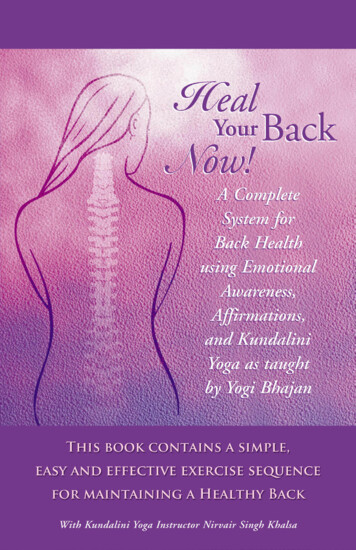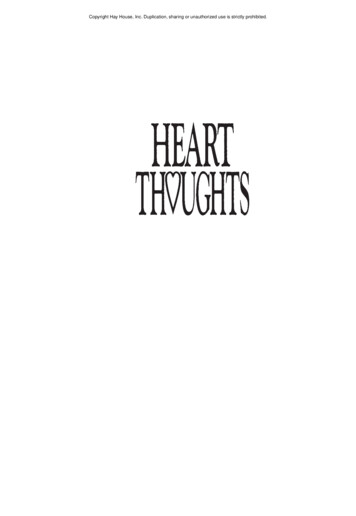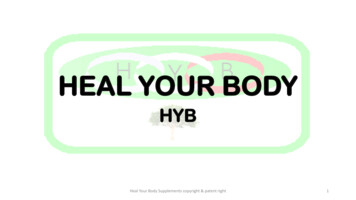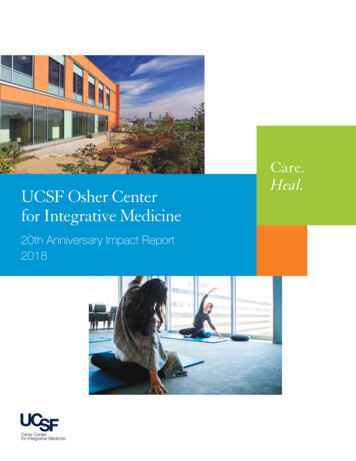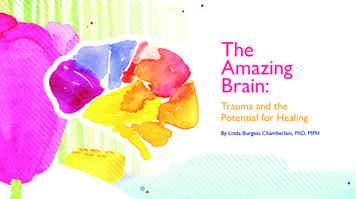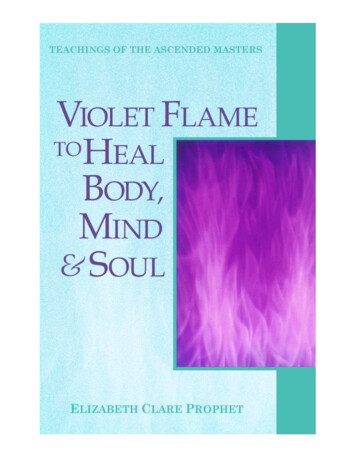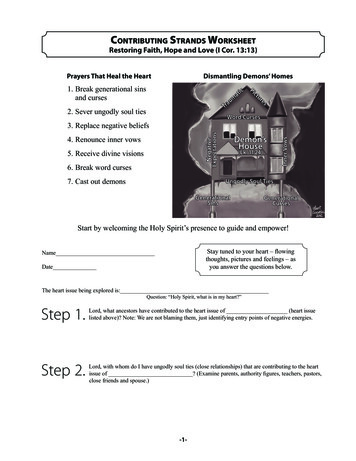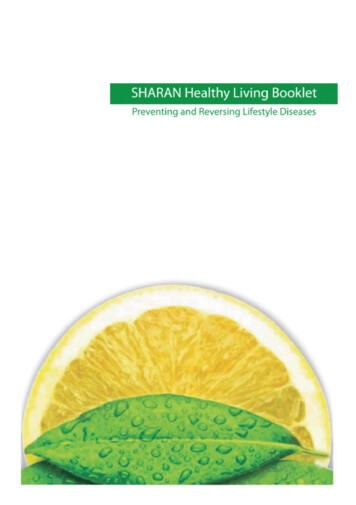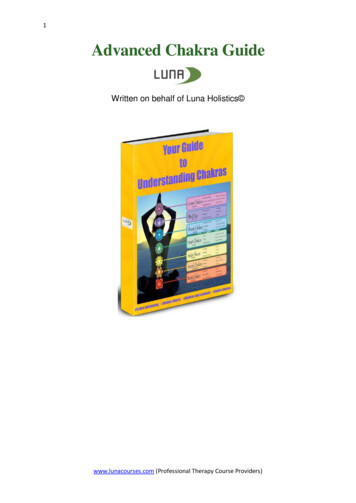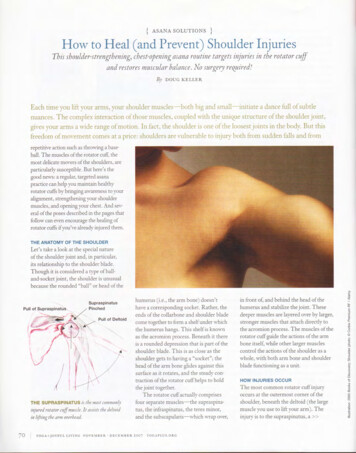
Transcription
{ ASANA SOLUTIONS }How to Heal (and Prevent) Shoulder InjuriesThis shoulder,strengthening, chest'opening asana routine targets injuries in the rotator cuffand restores muscular balance. No surgery reQ.uired!ByDOUG KELLEREach time you lift your arms, your shoulder muscles-both big and small-initiate a dan ce full of subtlenuances. The complex interaction of those muscles, coupled with e uni {.ue structure of the shoulder joint,gives your arms a wide range of motion. In fact, the shoulder is one of the loosest joints in the body. But thisfreedom of movement comes at a price: shoulders are vulnerable to injury both from sudden falls and fromrepetitive action such as throwing a base'ball. The muscles of the rotator cufT, themost delicate movers of the shoulders, areparticularly susceptible. But here's thegood news: a regular, targeted asanapractice can help you maintain healthyrotator cufTs by bringing awareness to youralignment, strengthening your shouldermuscles, and opening your ehest. And sev'eral of the poses described in the pages thatfollow can even encourage the healing ofrotator cuffs if you've already injured them.THE ANATOMY OF THE SHOULDERLet's take a look at the special natureof the shoulder joint and, in particular,its relationship to the shoulder blade.Though it is considered a type ofball,and'socket joint, the shoulder is unusualbecause the rounded "ball" or head ofthePull of Supraspinatusy----""'."". . /'- .SupraspinatusPinched,::-/Pull of Deltoid//// ",-'THE SUPRASPINATUS is the most commonlyinjured rotator cuJJmuscle. It amsts the deltoidin lifting the arm overhead.-0IYOGA JOYFUL LIVINGhumerus (i.e., the arm bone) doesn'thave a corresponding socket. Rather, theends of the collarbone and shoulder bladecome together to form a shelf under whichthe humerus hangs. This shelfis knownas the acromion process. Beneath it thereis a rounded depression that is part of theshoulder blade. This is as close as theshoulder gets to having a "socket"; thehead ofthe arm bone glides against thissurface as it rotates, and the steady con'traction ofthe rotator cuffhelps to holdthe joint together.The rotator cuff actually comprisesfour separate muscles-the supraspina'tus, the infraspinatus, the teres minor,and the subscapularis-which wrap over,NOVEMBER ' DECEMBER 20 07YOGAPLUS.ORGin front of, and behind the head of thehumerus and stabilize the joint. Thesedeeper muscles are layered over by larger,stronger muscles that attach directly tothe acromion process. The muscles of therotator cuff guide the actions of the armbone itself, while other larger musclescontrol the actions of the shoulder as awhole, with both arm bone and shoulderblade functioning as a unit.HOW INJURIES OCCURThe most common rotator cuff injuryoccurs at the outermost corner oftheshoulder, beneath the deltoid (the largemuscle you use to lift your arm). Theinjury is to the supraspinatus, a
THE DELTOID lifts the arm80 deg;ees; then the supraspinatusassists the deltoidJor the nextJa to 40 deg;ees.AS THE ARM LIFTS a shorteneddeltoid muscle causes the arm boneand the acromion process to pinchthe supraspinatus.small muscle that attaches directly to thehead of the humerus and assists the deI,toid in lifting the arm overhead. The verystrength of the deltoid is often the causeof injury to the supraspinatus.When you take your arms overhead,the deltoid is able to raise the arm to about80 degrees from the body. At this point,the deltoid can't do much more lifting onits own: the arm bone is almost level withthe shoulder, and from this angle the del'toid can only pull the arm bone into thejoint rather than lift it higher. As the armcontinues to rise, the deltoid relaxes some'what and the supraspinatus jumps in tohelp: it raises the arm for the next 30 to40 degrees, after which the deltoid canres urne its work.It is within this range of80 to r20 de'grees that the supraspinatus can get hurt.The tendon ofthe supraspinatus, which isabout the size of a large rubber band, is thepart of the muscle most often injured,though the muscle itself can also tear. Thiscan happen especially in hasty and aggres'sive adho mukha shpanasana (downward'facing dog) poses, as weil as in flamboyantversions of the newly popular pasisthasana(side plank pose), and in advanced armbalances such as tittibhasana.Simple accidents can also injure the72 IYOGA JOYFUL LIVINGNOVEMBER ' DECEMBER 2007YOGAPLU .ORGsupraspinatus tendon. For example, if youslip in an icy parking lot and use your armto break the fall, the humerus gets jammedin the socket, pinching the supraspinatusagainst the acromion process or eventearing the tendon. The simple repetitiveaction of raising your arm can also be atfault. When you reach for something on ashelf above you, the deltoid can pull thearm bone up too hard, pressing it againstthe acromion process, thus pinching thesupraspinatus. Over time, these little in'juries add up to a more serious problem.The shoulder is built to avoid thispinching, but our patterns of use andeveryday life lead to imbalance, pain, orlack of mobility. The problem starts withpostural habits: many of us overuse themuscles of the shoulders to support theweight of our arms. The muscles closest tothe neck (the rhomboids) and those run'ning from the tops of the shoulder bladesup into the neck itself(the levator scapu'lae) take the brunt of the weight. Thisis especially problematic during arm'intensive activities such as typing, whenyour shoulders become set in a perpetualshrug. Chronie tension builds up, pullingthe inner corners of your shoulder bladesup toward your ears, causing your back toround and your shoulders to hunch. This
WHEN THE SHOULDERblade releases down, tbe bead oftbe arm bone drops into tbejoint, wbicb makes spaceJor tbearm to 11ft furtber.is the beginning of a vicious cyde: the moreyour shoulder blades creep up the backfrom the puII of these musdes, the moreyour mus des tense and shorten, puIIingyour shoulder bl ades up even higher.As a result of this tension and thepostural misalignment that ensues, thedeltoid is far less likely to relax when it'ssupposed to. If your shoulders roll fowardand the deltoid remains fully engaged asyou lift the arm from 80 to I20 degrees, itcan cause the humerus to press againstthe acromion process, pinching the rotatorcuff tendon.There are a variety of yoga poses thatcan help break the cyde and restorestrength and balance to the shouldermusdes-from simple standing poses inwhich you hold your arms aloft in variouspositions to those in which your armsdirectIy support the weight of the body.The standing poses described below canhelp you reestablish the healthy mobilityof the shoulder blades as you lift yourarms; they will also enable you to activateother mus des to ease the burden on therhomboids and levator scapulae. Theinversions, particularly the headstand,strengthen the shoulder musdes, keepingthem more open and stress,free.Doug Keller's yoga journey includes 14 years ofpracticing in Slddha yoga ashrams, intensive traiwing in the lyengar and Anusara methods, and nearlya decade ofteaching in the U.S. and abroad.YOGAPL US . ORGNOVEMBER ' DE C EMBER 20 0 7YOGA JOYFUL LIVING73
TENSE WARRIOR "IJyour deltoids are terlSethey will cause your sholilders to hund).IJyolir sholilders arerelaxed,yoll'!lfeel the IIpper inner corners ofyollrsholilder blades release down, as the neck softem.FREEING THE SHOULDER BLADESfingers upward. The hunching dissipates:the upper inner corners of your shoulderblades release down your back, softeningthe sides of your neck. Feel how the weightof your arms is supported more by yourshoulder blades, which are plan ted firmlyon your back, and less by your neck: you'llespecially feel a firming ofthe muscles atthe outer edges of your shoulder blades, asthe deltoids soften and the shoulder jointsbegin to feel more open and free . Do a fewsmall arm circles to feel the support offeredby the shoulder blades .The same hunching tends to happenin parshvakonasana (side angle pose)when you extend the top arm overhead.Many students have trouble straighteningthe arm: the deltoid is tight, the shoulderTo begin, extend your arms out to eitherside in warrior II pose. Make sure yourarms are in the same plane as your shoul,ders or slightly forward of the shoulders.To experience "the shrug," rotate yourhands and arms so your thumbs facedownward: feel how the muscles on eitherside of your neck hunch upward, the del,toids tense, and the shoulders feel blocked.Now rotate your hands and arms so thepalms face up, even reaching your little/RELAXED WARRIOR "SIDE ANGLE POSE Avoid pinching inthe sholilder by bringingyollr arm slightlyforward and sweeping it in a C'shaped arc.Feel the shoulder blade release as the armswivels info place.YO GA JOYFUL LIVINGNOVEMBER ' DECEMBER 2007YOGAPLUS.ORG
is pinched, and the neck feels cramped,making it uncomfortable to turn thehead. The problem begins once againwith the shoulder blade, which fails torelease down the back so that the arm canswing into place in the shoulder joint.To release the shoulder in the sideangle pose, take your top arm s!ightly infront of your body and, while extendingout through the !ittle finger, rota te yourarm in a tiny are, making a C shape withyour hand, as if you were dipping your!ittle finger in a bowl of ice cream . Theshoulder blade will release down yourback and away from your ear, and thehumerus will swivel into place next toyour ear, making space for your head toturn. It's this simple yet elegant move'A regular, targeted asana practieeean help JOU maintain heafthJrotator euJfs by bringing awarenessto Jour alignment, strengtheningJour shoulder muscles, and openingJour ehest.ment of the shoulder blade that opensthe shoulder, and also, through a subtledownward pull of deeper muscles in theback and shoulders, prevents pinchingof the rotator cuff.PROTECTING THE SHOULDER JOINTFreeing the shoulder blades is just thebeginning. Protecting and healing therotator cuffs- the supraspinatus in par'ticular-involves not just realigning thebones, but activating and strengtheningthe muscles meant to counteract theupward pull ofthe deltoid. Straight'armposes such as downward'facing dog andadho mukha vrikshasana (handstand) certainly make use of these muscles, but theshoulder is also at its most mobile andvulnerable in these positions. It's saferto begin with variations on shirshasana(headstand), in which the position of thearms and shoulders is more stable. Andsince the aim of these headstand prep'aration exercises is to make the armsmore weight'bearing, the neck can remainsafe: !ittle, if any, weight needs to beplaced upon the head. »YOGA P LUS.O R GNOV E M B ER ' DECEMBER 2007YOGA JOYFUL LIVINGI 75
DOWNWARD DOGON WALL Create morespace within the shouldersby pressingyour forearmsand elbows info the wall.DOWNWARD DOG ON THE WALLThis exercise will help you establish cor'reet alignment in your shoulders withoutputting weight on your arms. Stand facingthe wall and place your forearms on thewall in headstand position, with your fin'gers interlaced and your elbows shoulder'width apart. Keep the palms of your handsseparated so that your arms form an76YOGA JOYFUL LIVINGupside'down U shape, rather than a V.Walk your feet back as you bend forwardfrom the hips. Maintaining the U shape, letyour arms slide down the wall until yourbody is at more or less a right angle (kneescan be bent if necessary), and your head isin line with your upper arms; the top ofyour head should not touch the wall.Lightly engage the inner edges ofyour biceps, drawing energy from yourinner elbows toward your armpits. Thisaction stabilizes and protects your shoul,ders because, when engaged, the bicepsdraw the arm bones back into the shoul,der joints. To keep your shoulders openand prevent pinching in the joints, iso'metrically s«-ueeze your elbows towardeach other while firming the biceps, as ifyou were s«-ueezing a beach ball betweenyour elbows . Feel how your upper backbroadens, much as it c1id when you turnedyour little fingers upward in the warrior IIexerClse.Press your forearms into the wall tostretch your upper body through theNOVEMBER' DECEMBER 2007YOGAPLU .ORGshoulders and away from the wall. If youare nursing an injury, go only as far as youcan without pain or stiffness in your shoul,ders; your head may only be an inch or twofrom the wall at first. That's fine. Noticehow pressing through your elbows makesyour shoulder blades firm into the back,creating more space within the shoulders.For comparison, press more with yourwrists and see how your triceps and del'toids activate, making your shoulderstighten and hunch. Pressing through theelbow when the arm is weight'bearing acti,"ates the deeper muscles-latissimusdorsi, subscapularis, and te res majorthat pull the head of the arm bane downand back, away from the acromion pro'cess; this prevents the pinching ofthesupraspinatus. While extencling back asyou press through your forearms into thewall, avoid overly rounding your upperback: let your spine descend from betweenyour shoulder blades toward the floor,while keeping your arms active. Hold thestretch for about 30 seconds.
between your hands, pressing throughthe arms firmly enough so that most ofyour weight is on your arms, not yourhead. Hold the stretch for about 30 seconds, keeping the arms engaged.If you can keep most of your weighton your forearms and do not experiencepinching in the shoulder joints, then stepfirst one foot and then the other onto thechair to elevate the hips, bringing moreweight into your arms. (To protect yourneck and build strength in your shoulders, you may want to practice with yourhead entirely off the floor, lifting so thatyour head comes in line w1th your upperarms.) Press the whole forearm into thefloor, especially through the elbows.HEADSTAND VARIATIONSIn the next exercise, remove the chair,VARIATIONS IN HEADSTAND Buzld strengthin Jour shoulders and protect Jour neck bJ pressing the length 01the forearms into the jloor.HEADSTAND WITH ACHAIRIn the next variation, the arms bear moreweight. This is where a prop becomeshelpfu!. Place a sturdy chair against awall so that it will not slide. Sit in front ofthe chair, facing away from it, and extendyour legs so that you can measure a leg'sdistance from the chair. When you gointo the pose, you will place your elbowswhere your heels are.Now come away from the chair andplace your hands and arms in headstandposition, with the elbows on the floor atthe spot you just measured. With yourfeet on the floor, toes curled under, liftyour hips up as if you were doing downward-facing dog. Lightly engage yourinner biceps and push your forearmsdown and away from you as you lift andstretch your hips back, creating a straightline from your elbows to your hips . Restthe crown of your head on the floorthen measure a leg's distance from thewal!. Rest the crown of your head on thefloor between your hands, with your fingers interlaced, your hands cuppedaround the back of your head, and yourwrist bones perpendicular to the floor.If you have neck concerns, you'll stillwant to keep your head off the floor, although it will be rather demanding. Comeinto the downward dog version first, thenstep your feet up the wall, so that yourbody is at a right angle- an upside-downversion of the exercise with which webegan. This pose is sometimes calledurdhva dandasana. Press through yourarms to take the weight off your neck andto lift your shoulders away from your earsand toward your waist. This engagesand strengthens the muscles that pullyour arm bones away from the acromionprocess, keeping the supraspinatus safeand allowing it to heal.How effective are these exercises formending rotator cuff injuries? In one studypublished in the International Journal oJYoga Therapy in 2006, IO people with rotator cuff injuries practiced similar variationsof the headstand for 30 seconds daily for sixweeks, with follow-up sessions every sixweeks, for an average of 4.9 months. Nineout of IO patients reported improved rangeof motion in the shoulders and reducedshoulder pain after the initial3o-secondsession. At the final follow-up, eight -,. YOGAPLUS.ORGNOVEMBER - DECEMBER 2007YOGA JOYFUL LIVINGI 77
HEADSTAND Collapsed shoulders cause thebody to arch into a banana shape (lift), whichstrains the rotator cuffs. To prevent this from hap'pening, press through the forearms while liftingthe shoulders away from the neck (right) .78YOGA JOYFUL LIVINGpaoents sho\\-ed significantly improvedrange of motion and a 75 percent re duc'tion in pain. None went on to surgery,which is unusual for people with rotatorcuffinjuries who report a significantamount of pain.If you already practice the full head,stand and are aware of the alignments andprecautions, you can include this asana inyour shoulder'strengthening'and'healingroutine. While in the pose, your wholeforearm should press fully into the floorto distribute your body's weight.In the headstand, the shoulders havea tendency to hunch toward the ears. Asa result, the body takes on a "bananapose." If you feel compression in yourlower back or neck, it's a sign that youare indeed in a banana shape. Press a bitmore through your elbows. At the sametime, with your thighs firm and steady,take your hips back slightly to alignthem more directly over your shoulders,and take your feet forward, reaching upthrough your inner heels and the moundsof your big toes. Keep your lower bellyNOVEMBER' DECEMBER 2007YOGAPLUS.ORGfirm to steady yourself; you should feelyour neck lengthen as you extend downthrough the crown of your head.As you press your elbows more fullyinto the floor, you will be able to broadenyour shoulders, lifting them away fromyour ears and toward your waist. Feel howthe outer edges of your shoulder bladesengage. The muscles you are using are thevery muscles which, when awakened andstrengthened through practice, create bal,anced action within your shoulders andprotect the rotator cuffs from injury.Because your shoulders play animportant role in so many daily activi'ties- playing musical instruments, typ'ing, driving, not to mention practicingyoga and playing sports-it's weil worththe effort to include inversions and shoul,der'strengthening exercises in your dailyroutine. And in the end, when the burdensofthe world prove to be a bit too muchfor your shoulders, the work of turningupside down can give them some welcomerelief. Atlas himself could have used a goodheadstand.
(side plank pose), and in advanced arm balances such as tittibhasana. Simple accidents can also injure the 72 I YOGA JOYFUL LIVING NOVEMBER ' DECEMBER 2007 YOGAPLU .ORG THE DELTOID lifts the arm 80 deg;ees; then the supraspinatus assists the deltoid Jor the next Ja to 40 deg;ees. AS THE ARM LIFTS a shortened deltoid muscle causes the arm bone
